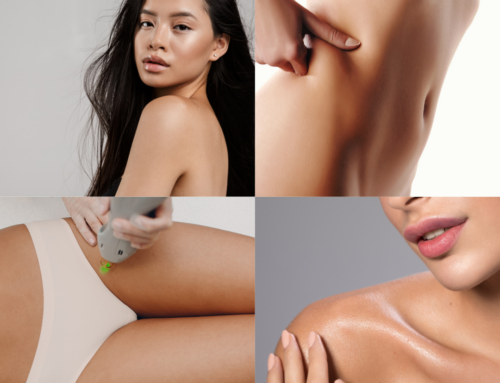Nose Filler vs Nose Job (Rhinoplasty): A Comparative Guide

Of all the cosmetic procedures available under the sun today, there arguably isn’t one as daunting as the nose job (also known as ‘rhinoplasty’). After all, our noses occupy a prominent position in the centre of our face, so even the slightest change to this facial feature can have a dramatic effect. With the right cosmetic procedure, however, you can make minor changes to your nose that provide all the aesthetic results you’re looking for.
But what is the right procedure for those of us who are only looking to make those minor changes – smoothing out a few bumps and contours or even just to correct a little quirky asymmetry? If you fall into this camp, then you’re likely to have already done a little preliminary research into nose fillers vs. nose jobs (rhinoplasty).
To help you on your path, we’ll be providing expert answers to some of the most common questions that must be asked in the great debate that is nose fillers vs. rhinoplasty, and in your own process of determining which procedure is right for you. Read on to unearth all the top considerations you’ll need to make when comparing nose fillers and rhinoplasty (nose jobs) for your own personal beauty and wellness planning.
In this short guide, you will learn:
- What are nose fillers?
- What are nose jobs (rhinoplasty)?
- Pros & Cons
- Who are good candidates?
- What can you expect?
- How to find a rhinoplasty surgeon
What are nose fillers?
Rhinoplasty (or ‘nose jobs’) has been a hot topic for the past few decades now, with tens of dozens of celebs and key public figures advocating for the procedure. But nose fillers may not be as widely renowned for a few key reasons. So to start off, let’s outline exactly what nose fillers are.
In short, nose fillers are a nonsurgical alternative to traditional rhinoplasty procedures. Often referred to as ‘liquid rhinoplasty’, nose fillers really work in just the same way as the majority of other dermal fillers, and typically involve cosmetic specialists injecting a either a calcium hydroxylapatite or a stabilised hyaluronic acid (HA) gel solution into a patient’s nose to improve contours or correct bumps. As these solutions dissolve over time, the results of nose fillers are temporary, and so repeat treatments will be required every 6-12 months.
What are nose jobs (rhinoplasty)?
Contrastingly to nose fillers, nose jobs (AKA ‘rhinoplasty’ or nasal reconstruction) is the process of using surgical methods to permanently alter or reconstruct the nose. Rhinoplasty is typically performed to either improve the appearance of the nose or to fix defects that could raise medical concerns (i.e. a deviated septum, cleft palate, saddle nose, ageing nose, etc.).
Year after year, rhinoplasty is consistently one of the most commonly sought after cosmetic procedures across the globe. This is both due to the procedure being able to deliver exceptional aesthetic results, but also in the role that rhinoplasty treatments can play in improving breathing functionality and even sleep quality in patients diagnosed with sleep apnea.
Pros & cons: nose fillers vs. nose jobs (rhinoplasty)
If you’re looking to secure a nose filler or rhinoplasty as a cosmetic treatment or to correct any medical conditions caused by nasal defects (i.e. sleep apnea), then it definitely pays to familiarise yourself with the unique benefits and disadvantages of each procedure.
Here’s just a quick overview of some of the primary pros and cons to consider in the debate of nose fillers vs. nose jobs (rhinoplasty):
Nose fillers
Pros:
- The procedure is quick, typically taking only 15 minutes
- The procedure is non-invasive
- The procedure is affordable and cost-effective
- The procedure is reversible with injections of hyaluronidase (if using HA gel fillers)
- Results of the procedure are immediate
- The procedure has a minimal recovery time
- No anaesthesia is required, so patients can review results in real-time
- Can be ideal for patients looking to secure nasal reduction
Cons:
- Results are impermanent, so retreatments will be required to maintain effects
- Potential of vascular complications if filler injections are misapplied
- Potential for side effects like bruising and swelling
Rhinoplasty
Pros:
- A one-time purchase and procedure without the need for repeat treatments
- Results of the procedure are permanent
- Can correct nasal defects that may cause breathing issues and other medical problems
- Can be scheduled simultaneously with other similar cosmetic procedure (i.e. chin augmentations)
- Can be used in tandem with nose fillers (if minor amendments are still required post-surgery)
Cons:
- As the procedure is surgical, it does possess greater risks than nose fillers
- Can be costly when compared to nose fillers
- Will require that patients go under anaesthetic
- Longer recovery time of 2-4 weeks (longer in comparison to nose fillers)
- Final results may take up to a year to see (due to swelling and other side effects)
- If revisions are required, patients won’t know until a year after the procedure has been completed
Who would be a good candidate?
Now that you know the general pros and cons for nose fillers vs. nose jobs (rhinoplasty), it’s time to determine whether or not you’d be a good candidate for either procedure. Naturally, the foundation of a good candidate for any cosmetic procedure is a candidate who has educated themselves on both the benefits as well as the risks involved with the treatment they’re looking to secure. If you have a thorough understanding of the risks that may accompany your treatment, you can make a more informed decision about whether or not that procedure is right for you.
And as for what makes for a good candidate physiologically, generally speaking an ideal candidate for nose fillers or liquid rhinoplasty would be someone who’s looking to correct minor defects like smaller nasal bumps or just a slight droop to the tip of their nose. These minor defects can easily be corrected by using nose fillers to enhance preferred parts of the nose and smooth the appearance of bumps or droops.
If you’re looking for more dramatic results or even to repair or restore the shape of your nose following some nasal trauma (i.e. a broken nose or a fracture of the bones in your nose), then a rhinoplasty or nose job procedure may be more appropriate for you. At the end of the day, however, it’s up to your cosmetic surgeon to determine whether or not you’re an ideal candidate for either procedure, so be sure to consult them if you are looking to secure either rhinoplasty or nose fillers.
What can you expect from your nose filler or nose job (rhinoplasty) procedure?
So what can you expect on the day of your nose filler or rhinoplasty appointment? For your nose filler appointment, you’d be surprised by just how quick the procedure will be. All that’s really involved with a nose filler appointment is an initial consultation, followed up with the cleaning of the nose, applying numbing cream or ice (if the filler being used doesn’t already have a local anaesthetic), and then the filler solution will be carefully applied where needed. Once the solution has been applied, all that’s left to do is monitor the results and any symptoms over the next 1-2 weeks.
As for rhinoplasty procedures, you can naturally expect rhinoplasty to be a little more time intensive. In your preliminary consultation, you’ll be able to share photographs of your nose with your specialist, or 3D images of your nose are taken alongside an internal nasal examination to map out potential corrections. Following this, your cosmetic surgeon will book in your procedure for a later date. Some patients may even receive a second consultation prior to their procedure if their cosmetic surgeon deems it necessary.
The rhinoplasty procedure itself takes place whilst the patient is under sedation, as rhinoplasty (nose jobs) typically involve cutting through the nostrils, cartilage, and in some cases even through bone to restructure the nose. Once the procedure has been performed, the patient usually stays at the facility overnight or is supported in their journey back home by a friend or family member, as their anaesthetic will still be wearing off. From there, pain management medication should be taken to support the patient through the initial weeks of recovery. Patients are typically also asked to sleep sitting up for the first 1-5 nights to help support their recovery process.
How to find a rhinoplasty surgeon?
Now that you’ve absorbed all this information, you should have a stronger understanding of which procedure you’re leaning towards. But just as a refresher:
- Nose fillers are ideal for any patients looking to correct minor nasal defects
- Rhinoplasty (nose jobs) are ideal for any patients looking to restructure the look and shape of their nose, either for aesthetic purposes or to correct medical conditions like sleep apnea
And now that you’ve got all this information on hand and have a stronger understanding of what objectives you’re looking for, all that’s left to do is find the right cosmetic specialist or clinic to help you attain those results – that’s where Pirk comes into the picture.
Speak with our Cosmetic Consultant today to help us connect you with the right rhinoplasty specialist for your next nose filler or rhinoplasty procedure. Contact us or call our Pirk team today at 1300 114 426. Alternatively, reach us via email at hello@pirk.au.
The information presented in this blog and on the Pirk’s website is intended for general informational purposes only and should not be considered professional advice. While we collaborate with qualified surgeons, we are not medical specialists, and the content provided is of a general nature. It is strongly recommended to seek personalised professional advice tailored to your specific situation.
If assistance in finding a qualified surgeon is needed, Pirk can offer support. This content does not constitute personal advice, diagnoses, or treatment plans. By reading our blogs, you acknowledge and accept these terms. For further assistance or clarification, please contact us at hello@pirk.au.

